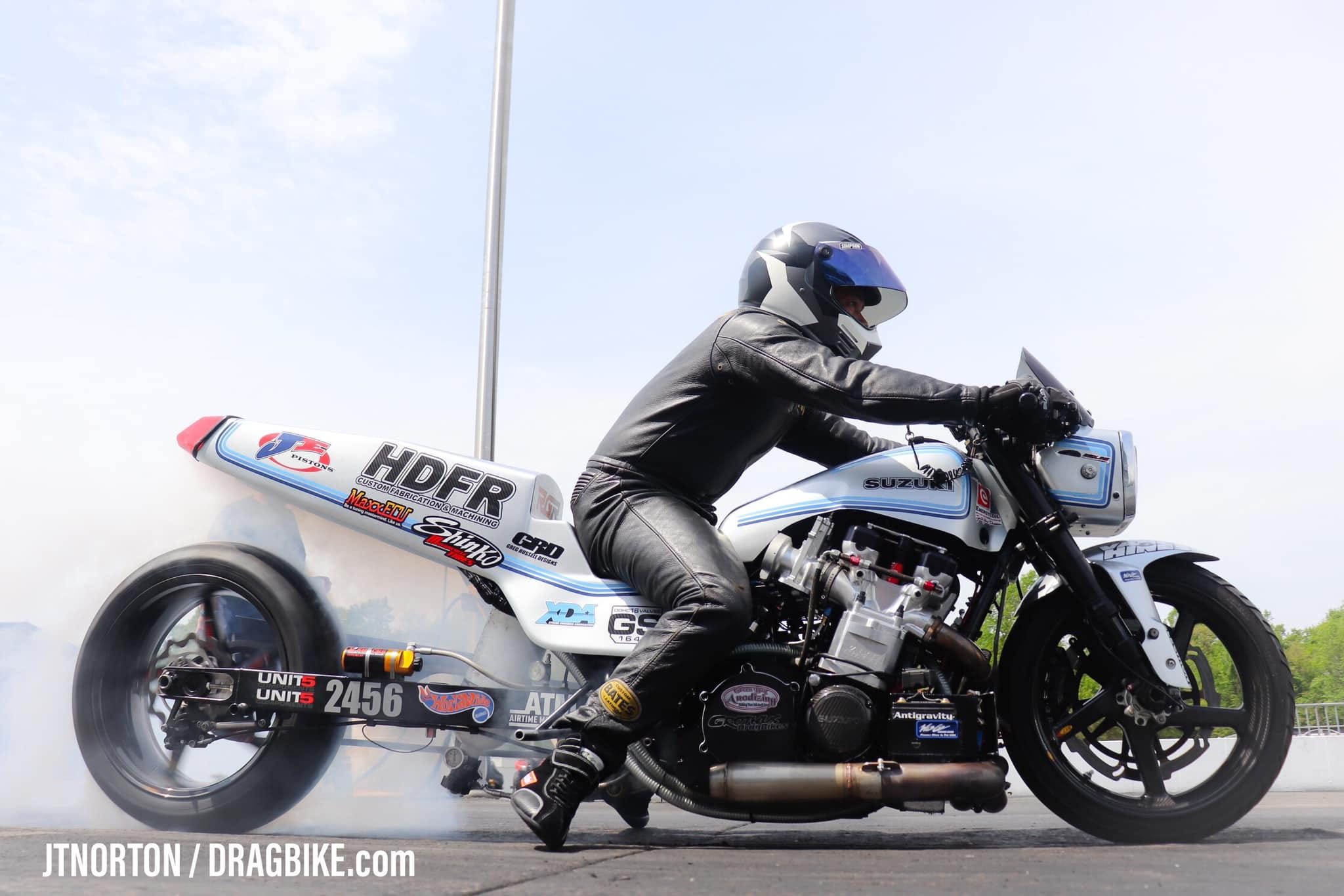The 550+ HP Suzuki GS Nitrous Pro Street Drag Bike
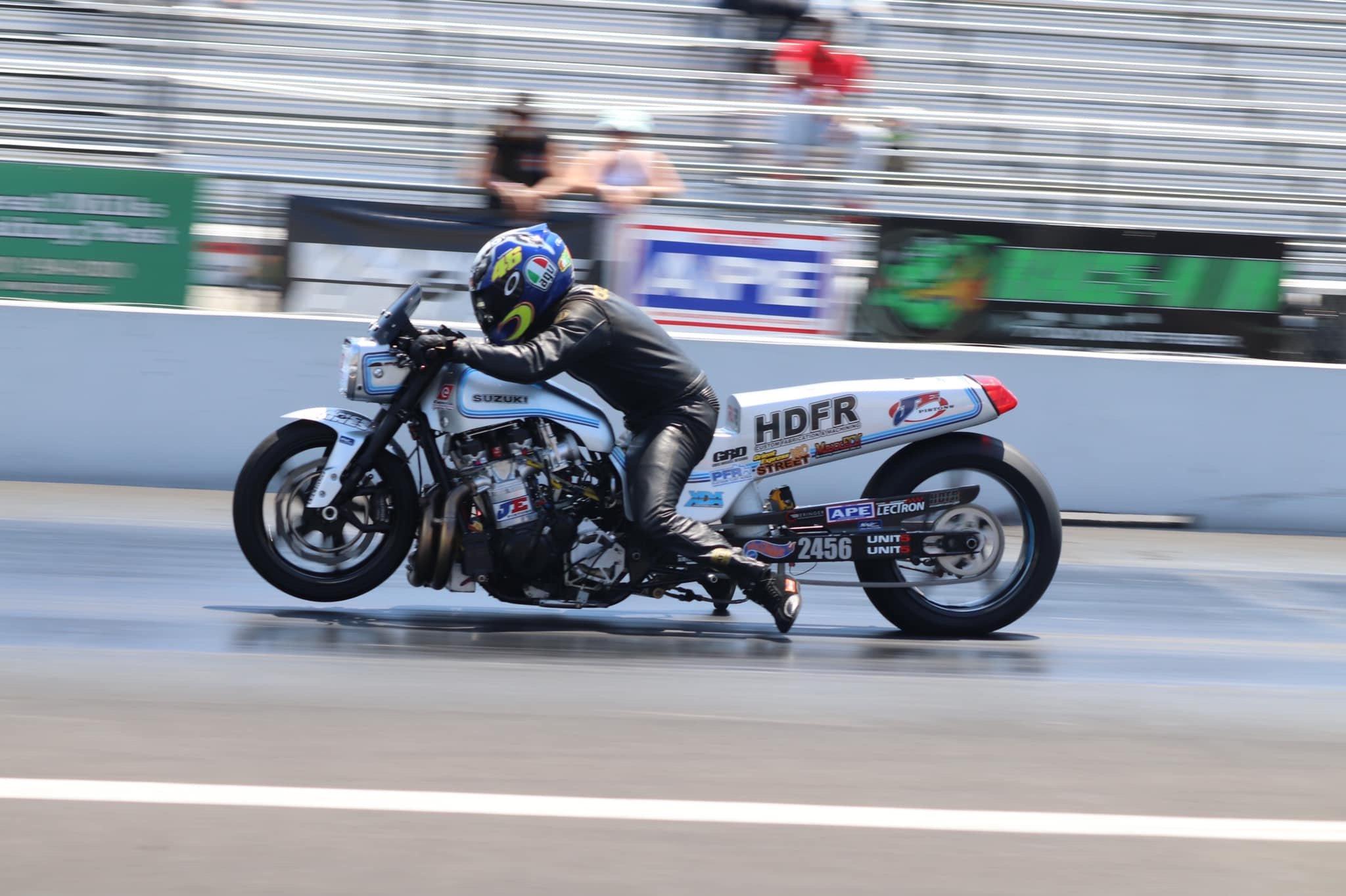
Brad Mummert’s iconic 1980 Suzuki GS Pro Street nitrous drag bike piloted by Richard Gadson is one-of-a-kind. We sat down with this drag race duo to find what went into this record-holding machine and what it’s like to be behind the bars.
Like most gearheads, Brad Mummert grew up in a racing family. His influence came from his father and uncle, who steered his trajectory toward adrenaline-pumping drag racing. Instead of playing traditional stick-and-ball sports, Mummert grew up at the racetrack. It wasn’t until he got older that Brad turned his attention to motorcycle racing. “I couldn’t afford cars and didn’t have a place to work on them, either,” explains the Pennsylvania native. “Motorcycles were the logical choice. I knew that if I was going to race something, it was going to be a motorcycle.”
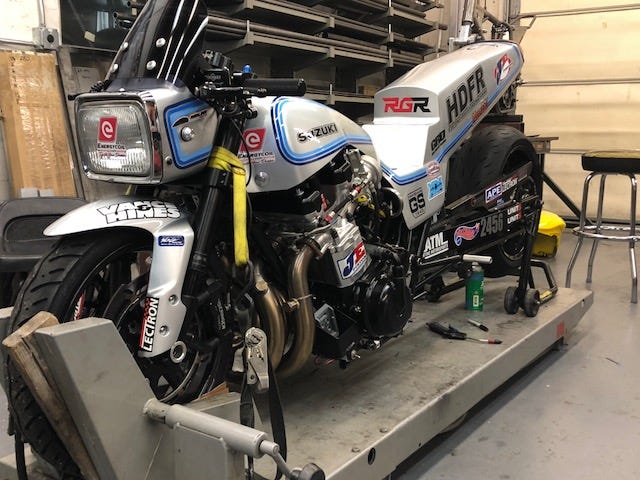
You could say that Mummert has devoted his life to Pro Street, which is a specific classification in drag racing. Next year will be the 25th anniversary of Pro Street. Brad was at the very first race in Bowling Green, Kentucky, all those years ago.
Every competitive person is wired in a way that they strive to improve. Brad Mummert fits that description to a ‘T.’ He wanted to make something better, faster, lighter and stronger. His friend, Mike Schultz, encouraged him to take the plunge. Then life happened. Marriage, kids and responsibilities changed Brad’s focus. Fortunately, when he did return to the drag strip, Mummert was all-in on the idea of building a 1980 Suzuki GS. “It became a school science project that went all wrong [laughter]. Things got out of control. [Racer] Richard Gadson got involved. He would tell me over and over, ‘Wow, this bike is really fast, but if we make this or that modification it will be super-fast.’ Things kept evolving,” explains Brad.
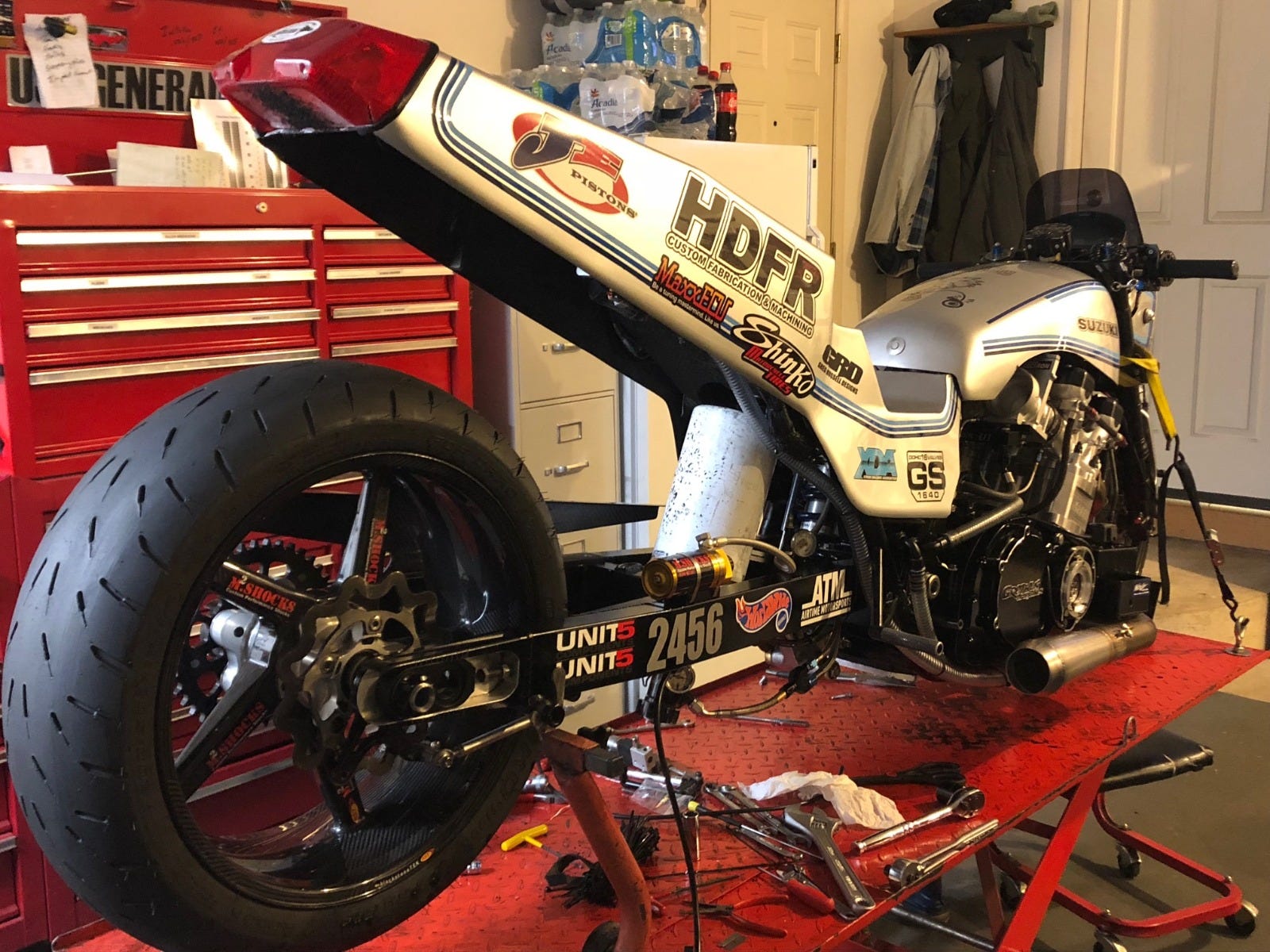
According to Mummert, building the GS became a sort of science project. Trial, error, and experience played a big part in taking the bike from really fast to super-fast.
For those unfamiliar with Pro Street, Mummert’s choice of racing on a 1980 Suzuki GS over the popular turbo-charged Hyabusas was like bringing a knife to a gun fight. Antiquated and archaic, the GS was at an immediate disadvantage on the drag strip. That didn’t dissuade Mummert from going full steam ahead. “I like old stuff,” admits Brad. “I had an attic full of Suzuki GS parts. I like the old-school bodywork, and no one else was doing it. Everyone has turbo Hyabusas. I didn’t like the cookie-cutter approach. Having said that, I had no intentions of going as fast as we are today.”
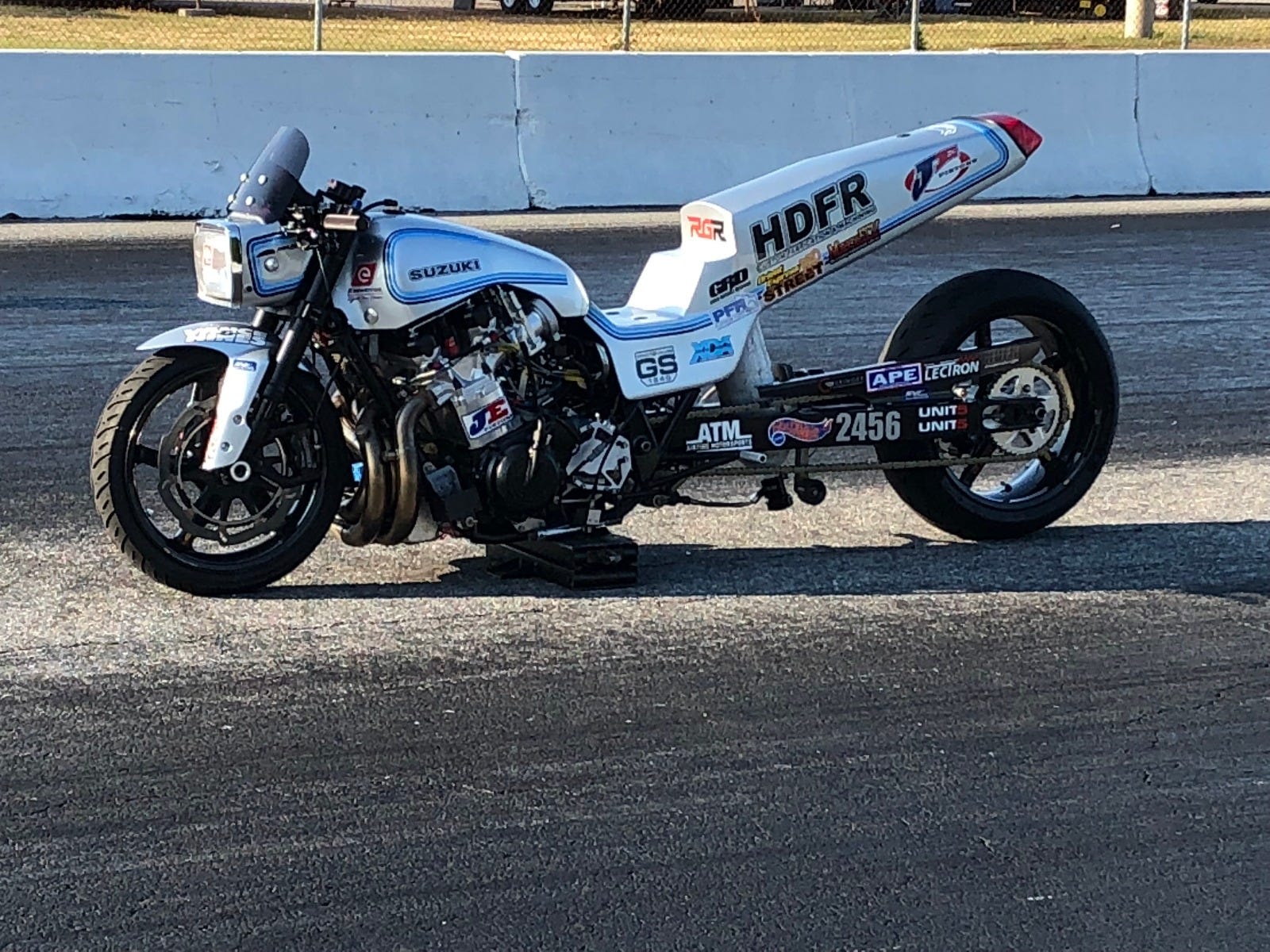
The GS undoubtedly stands out among the rest of the Pro Street class, which is commonly littered with turbo Hyabusas.
Richard Gadson, Mummert’s pilot on the Suzuki GS grand adventure, is cut from the same cloth as Brad. The 33-year-old nephew of 14-time National Champion Rickey Gadson, Richard is a fan of the strange and unusual. He, like Mummert, feeds off competition and rivalry.
Gadson explains, “In our early stages one of the top turbo guys told us, ‘You’re never going to win on that bike.’ He didn’t mean it like we took it, but that really created this goal of winning on the Suzuki GS. Nobody was running fast on nitrous. We could have raced on a turbo, and it would have been cool, but no one was going to be talking about it on the Monday after a race win. I look for the challenge. I go against the grain.”
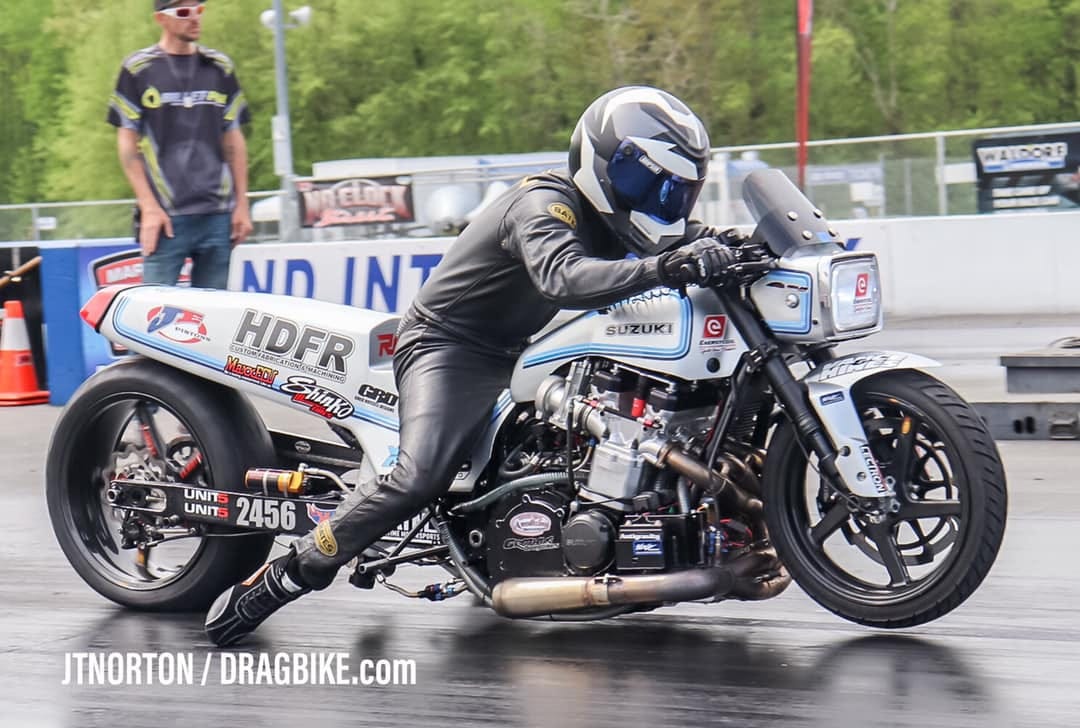
Richard Gadson is the mad-man that chooses to pilot the Nitrous GS. Simply put, he goes against the grain.
The project began in 2010. At that time nitrous bikes were not very competitive. The rulebook favored turbo-charged engines, but Mummert still went the nitrous route anyway. With Gadson at the helm, they set their sights on breaking records. However, the first-generation setup was very inconsistent. Using a trouble-shooting method, they progressed toward revised settings. Next came several chassis changes, followed by making the bodywork out of carbon fiber in order to reduce weight. A big technological leap came in outfitting the Suzuki GS with electronic fuel injection (EFI). That created several hurdles for Mummert and his team.
“Two seasons ago we elected to go with EFI,” explains Brad. “We could go fast, but not consistently fast. We would lay down a really killer number, then come back and make changes that we thought would improve the run, but we would actually go the opposite direction. We couldn’t figure out why. Over time we actually have been able to tune the fuel injection. That has made a big difference.”
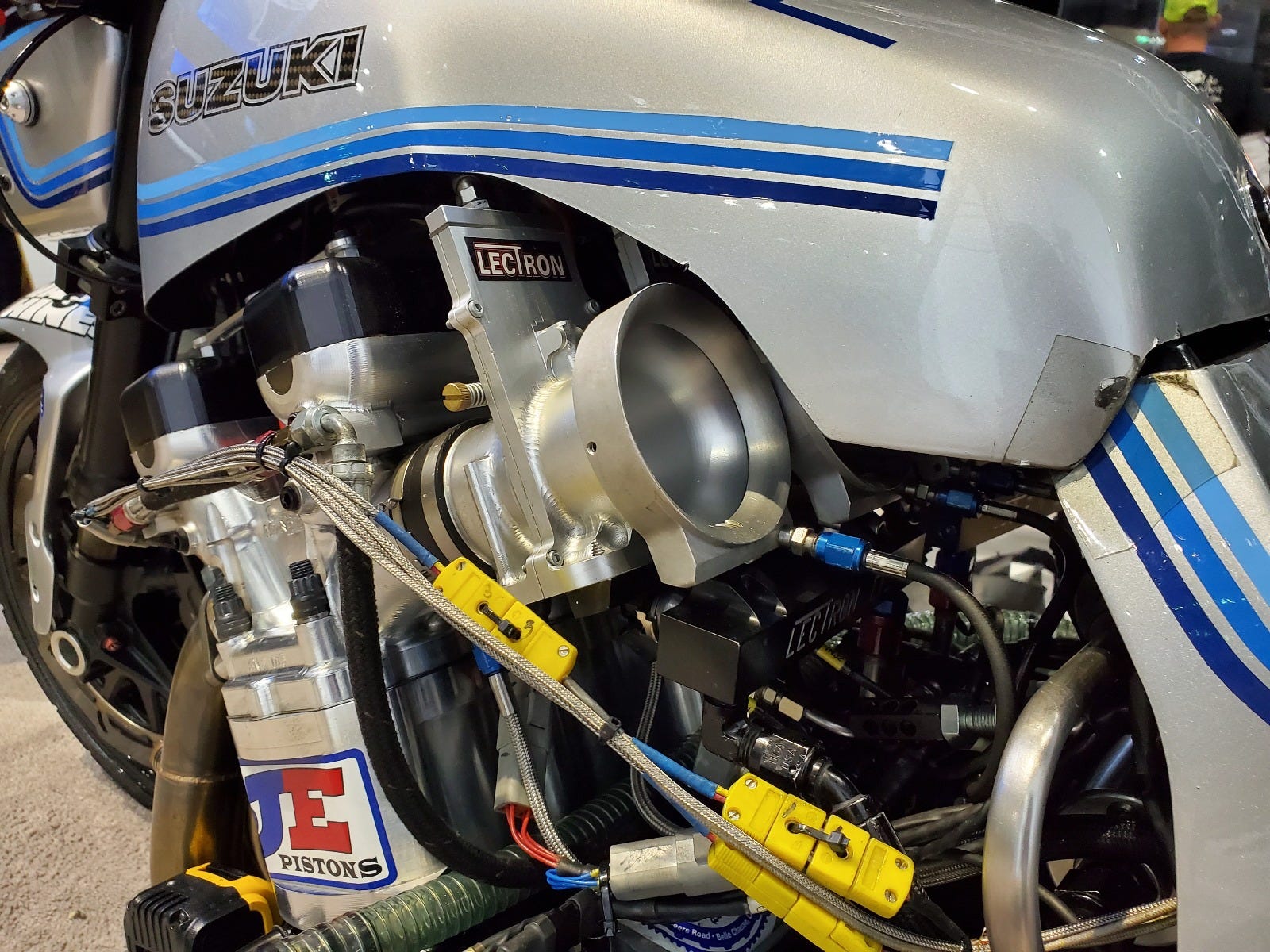
Testing and fine-tuning the custom fuel injection system allowed for big strides to be made in fast passes.
Around the same time Mummert equipped the Suzuki with EFI, he got his hands on a MonStar billet cylinder head. That was a major turning point. In terms of dependability, it was the biggest step forward that Brad made. Keep in mind that the old OEM/stock castings were 30 years old, and nothing more than epoxy and some welding to get the ports and valves big enough. As a result, the castings wouldn’t hold up. Although great in the early going, that method caused slower times as a race weekend wore on. The billet cylinder head provided consistency, which is crucial when dealing with the loads that are placed on the Suzuki GS engine.
Richard Gadson offers refreshing perspective on what it has been like to be a part through the various iterations and changes of the Suzuki GS project build.
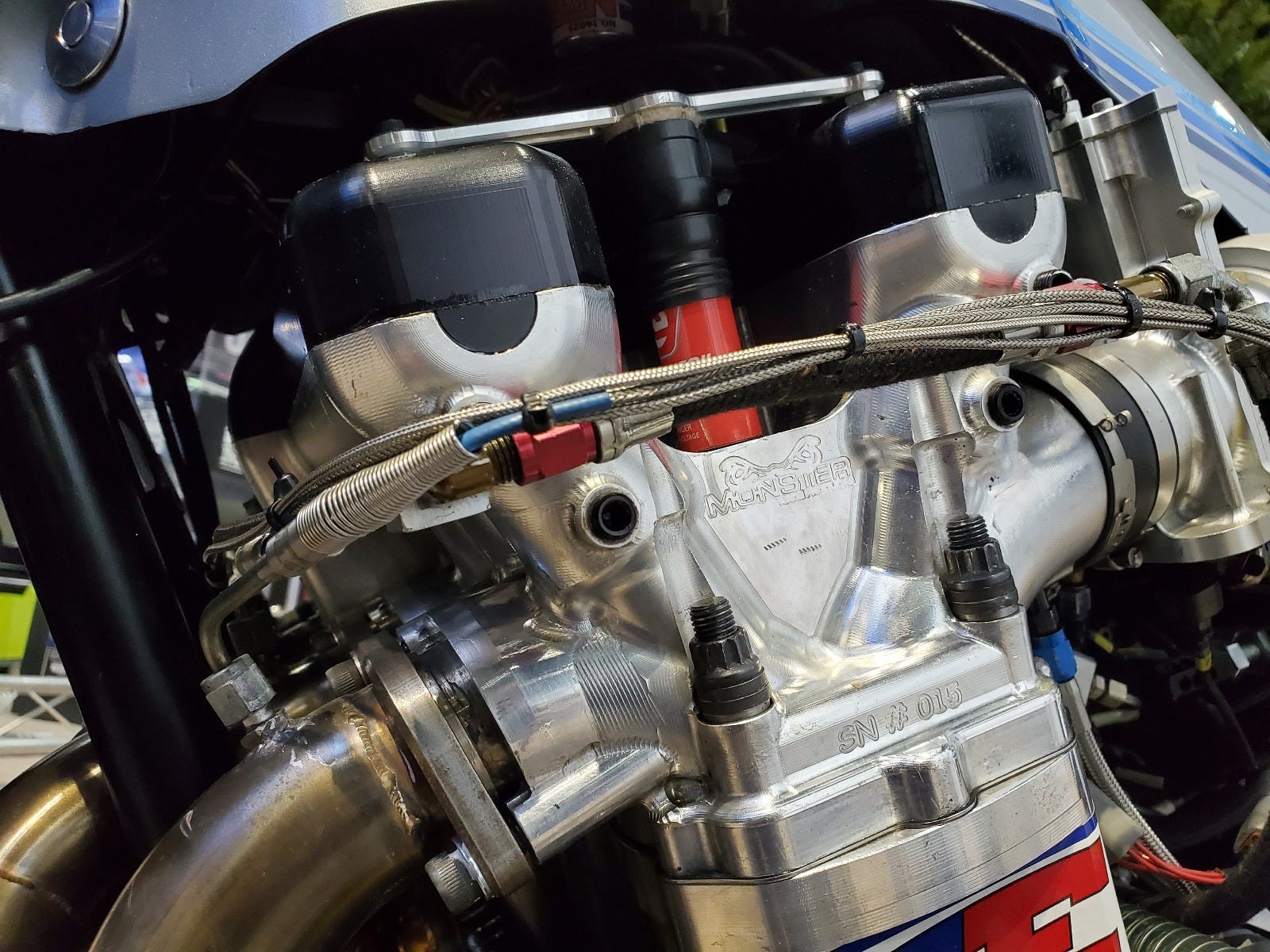
The billet head provided more consistency and more power through better flow for the GS. A big upgrade over the 39-year-old cast part.
“I don’t have any children, so I don’t know what it’s like to raise young kids, but this project has to be what it feels like,” states Gadson. “To be a part of something in its early stages, have all these hopes and dreams and aspirations for it, and see it manifest is the most gratifying feeling.”
Every gearhead wants to know about horsepower numbers. After all, power is the measuring stick in any motorsport. Mummert wasn’t shy in revealing his bike’s engine stats.
“We’ve never been able to run the engine on the dyno with all of the nitrous on it, because it won’t stay hooked on the roller,” states Brad. “We ran it naturally aspirated to get our base tune-up in, and then we ran it on our first stage of nitrous. At that point it was making 320 horsepower in the first kit. We put about another 250 horsepower on top of that, so it should be between 550 and 600 horsepower.” Given that Mummert’s 1980 Suzuki GS weighs in the neighborhood of 600 pounds with the rider, the bike has a remarkable power-to-weight ratio.
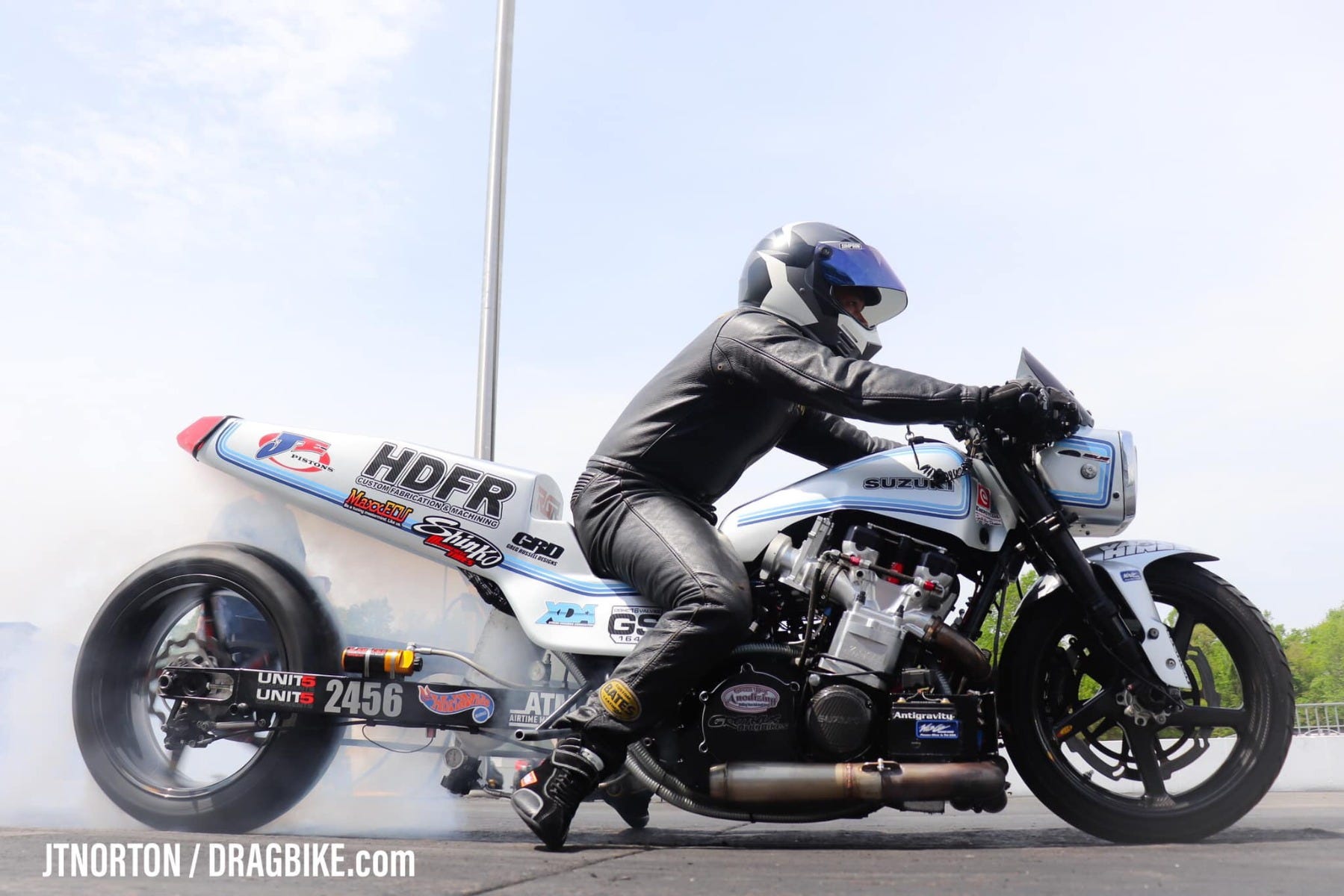
The nitrous-huffing GS monster is making 550+ horsepower accounting for the dual-stage nitrous. Pretty incredible out of a 4-cylinder drag bike if you ask us.
Speaking of weight, as previously mentioned the bodywork and subframe were made out of carbon fiber. The goal was to shave as much weight as possible. Having said that, at one time Mummert strapped 12 pounds of lead on the front of the bike to change the weight balance. He soon realized that if he was going to strap dead weight on the bike, why not bolt on a 12-pound vacuum pump that gains horsepower instead? Brad had to do some crafty engineering to get the pump to tuck in under the exhaust, but it was worth the headache. The vacuum pump gained him 15 horsepower.
Weight and horsepower aside, the true barometer for a drag racer is in pass time, or how quickly can the machine go from standing still to covering ¼ of a mile. Mummert and Gadson set an initial goal of breaking into the six-second range back when they began their endeavor. By the start of the 2019 season, the goal was to break the 6.50 barrier. While they weren’t the first to do so, they managed a 6.40 flat by the end of the season. It was a huge feat.
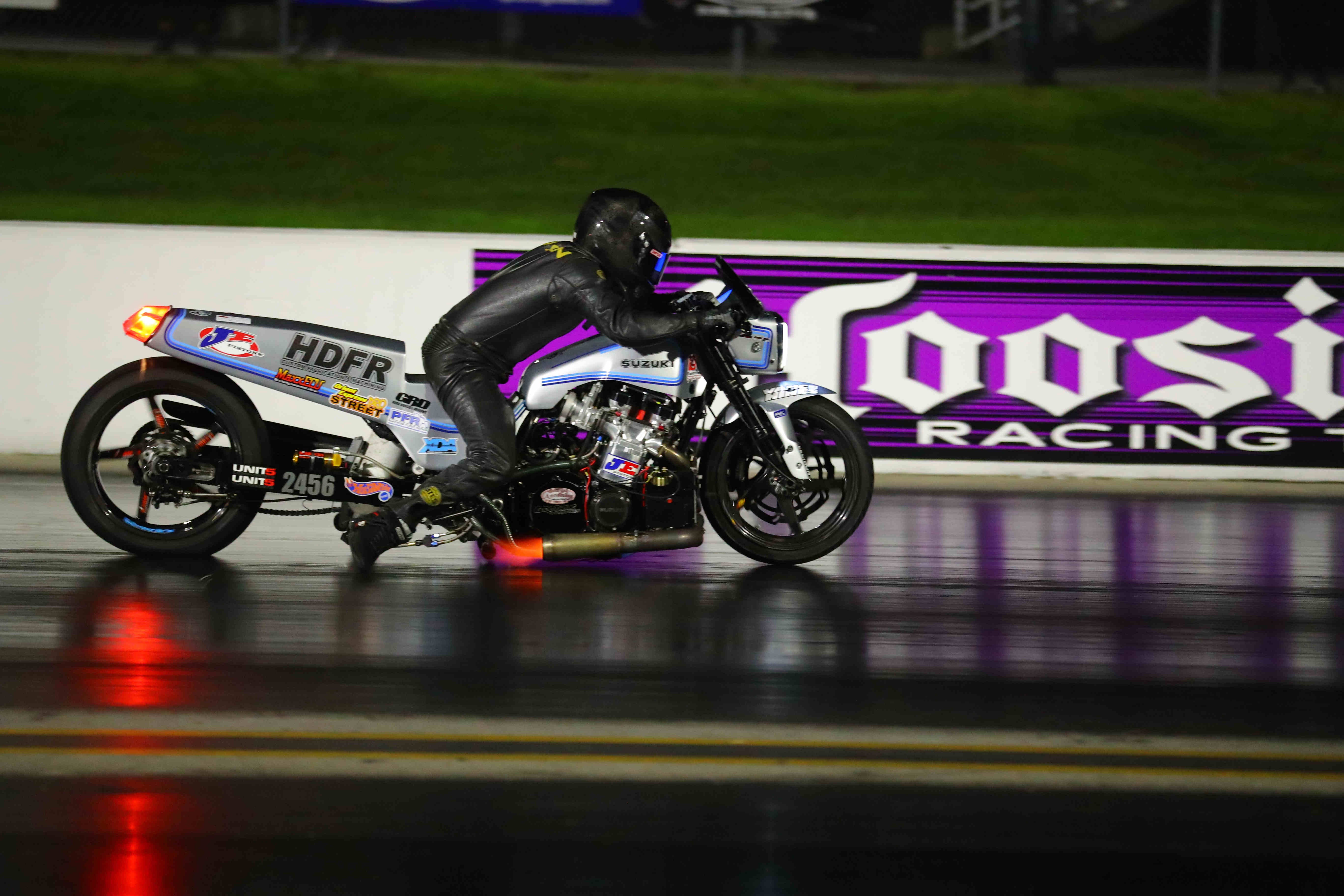
Through a fast-paced series of record setting and re-setting, Mummert and Gadson ran a 6.40, the quickest Nitrous Pro Street bike pass yet.
Mummert points to one main reason as to why they were able to progressively improve their pass times.
“We have a good tune-up and the parts are living,” explains Brad. “We’ve had years where I had to replace the crankshaft or end up re-doing the cylinder head. We have kind of corrected everything that has caused us problems.”
An area of major concern prior to 2019 was piston life. Mummert’s Suzuki GS engine was chewing through a set of pistons at every race. The pistons would start going out after six runs. Fortunately, Brad had a good friend who introduced him to JE Pistons.
“Del Flores and I raced together for a long time, and he came up to me at the PRI show in 2018. He asked what pistons I was running. I told him that I was having a tough time with piston reliability. He told me that he was going to get me a piston deal that same weekend. I laughed! Del had a good relationship with JE Pistons. He walked right up to them and said that they needed to work with me. After an introduction, JE gave me a couple sets of pistons, and it has grown from there. I think it’s beneficial for both of us. I sold a lot of pistons for them, and the ones they gave me are still in the bike.”
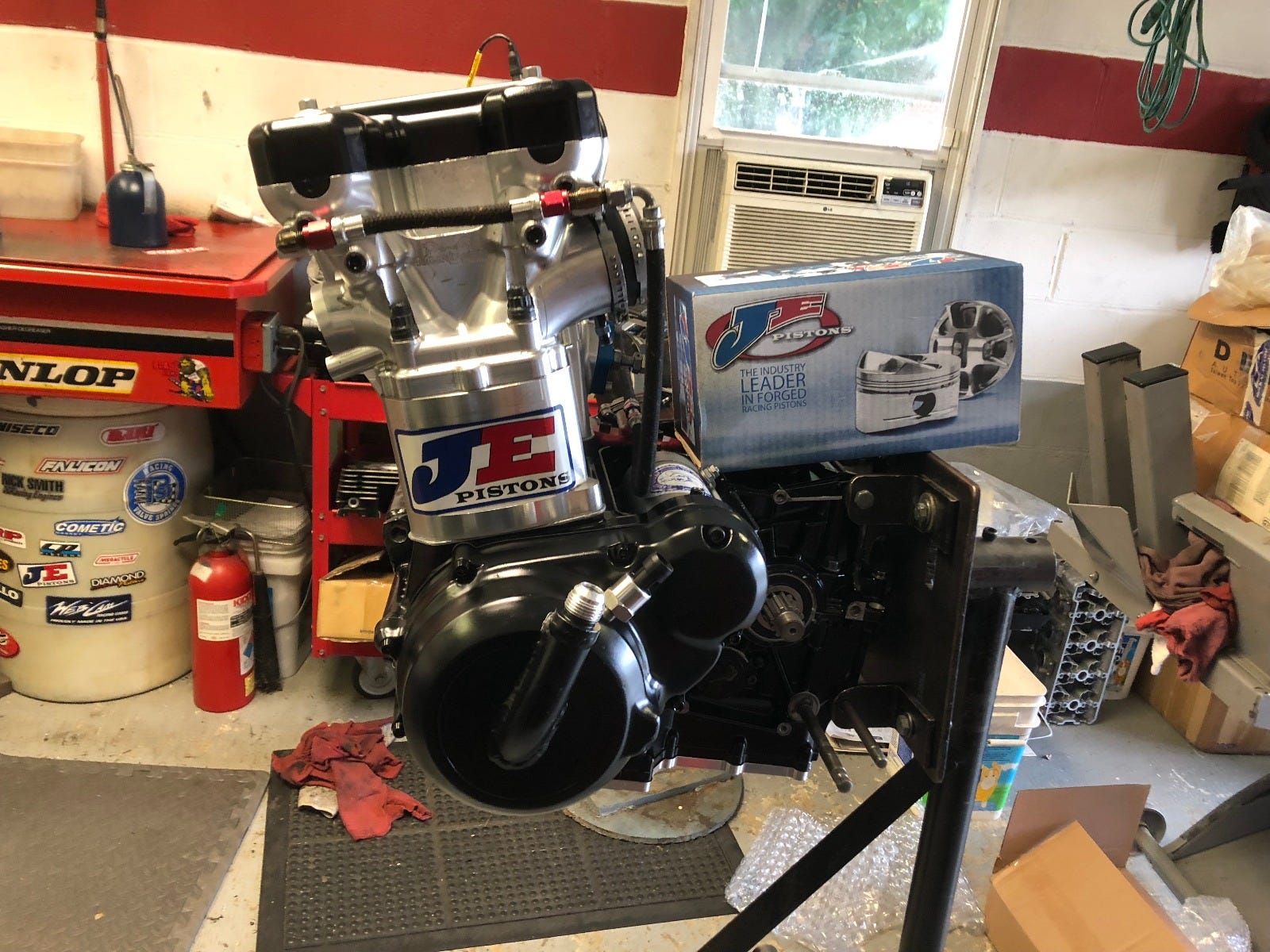
After experiencing serious piston survival issues, Mummert made the switch to JE Pistons. Since, they are still running the first set they received, with no wrist pin bore, crown, or ring land problems at all.
Need pistons for your machine? Check some out here.
Mummert continues, “After switching to JE Pistons, I tear the bike down to inspect everything and the pistons looks great. There’s no issue with wrist pin bores, which is where we were having problems last year. There aren’t any problems with the top of the pistons. We’re not lifting ring lands. Some of that may be tune-up related, but a whole bunch of it is that the JE Piston is a much better design and stronger than what we were running in the past. Usually I replace the rings after about 40 runs. That’s it.”
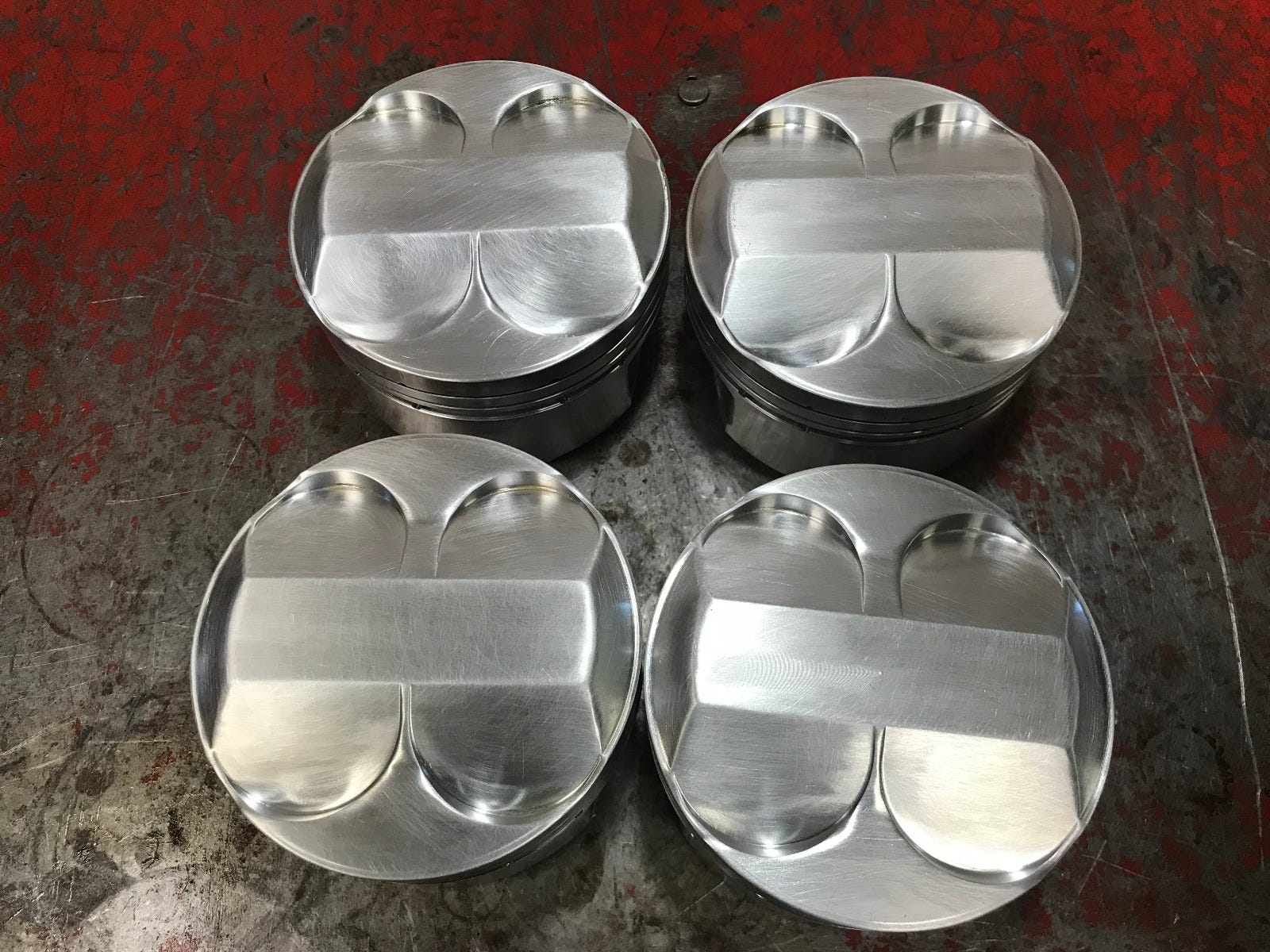
These are Mummert’s JE pistons after 23 nitrous passes. Cleaned up, inspected, and ready to go back in the bike for more abuse. Just a ring refresh is all Mummert has deemed necessary.
Want some more tech info on custom pistons? We have all the details!
Vance & Hines has been a big part of Mummert’s build. Eddie Krawiec from V&H did all of the engine case works. The company also supplies the crankshafts and blocks. Aside from the aforementioned JE Pistons, Brad uses Robinson Industries billet five-speed transmissions, a MonStar billet cylinder head, Victory valves, WebCams camshafts, Lectron Fuel Systems throttle bodies, and a Maxx ECU. There’s also some pretty trick ignition parts care of Energy Coil.
There is undoubtedly a laundry list of unique parts on Mummert’s 1980 Suzuki GS. What stands out to Brad?
“We’re attempting to do what may seem impossible using the body style that we have,” admits Mummert. “For me, it’s running the old-school bodywork. There’s no fairing and we’re running over 200 miles an hour, competing against turbo bikes with fairings. People point out that my bike doesn’t have much GS-based stuff on it, and they’re right. It’s all new-school technology when you look at the powertrain. I point out that if you look at a Pro Mod car, like a 1969 Camaro or a 1941 Willys, whatever body style they run, they also put in a different powertrain. That’s all we’ve basically done. We took an old body style and put new components around it.”
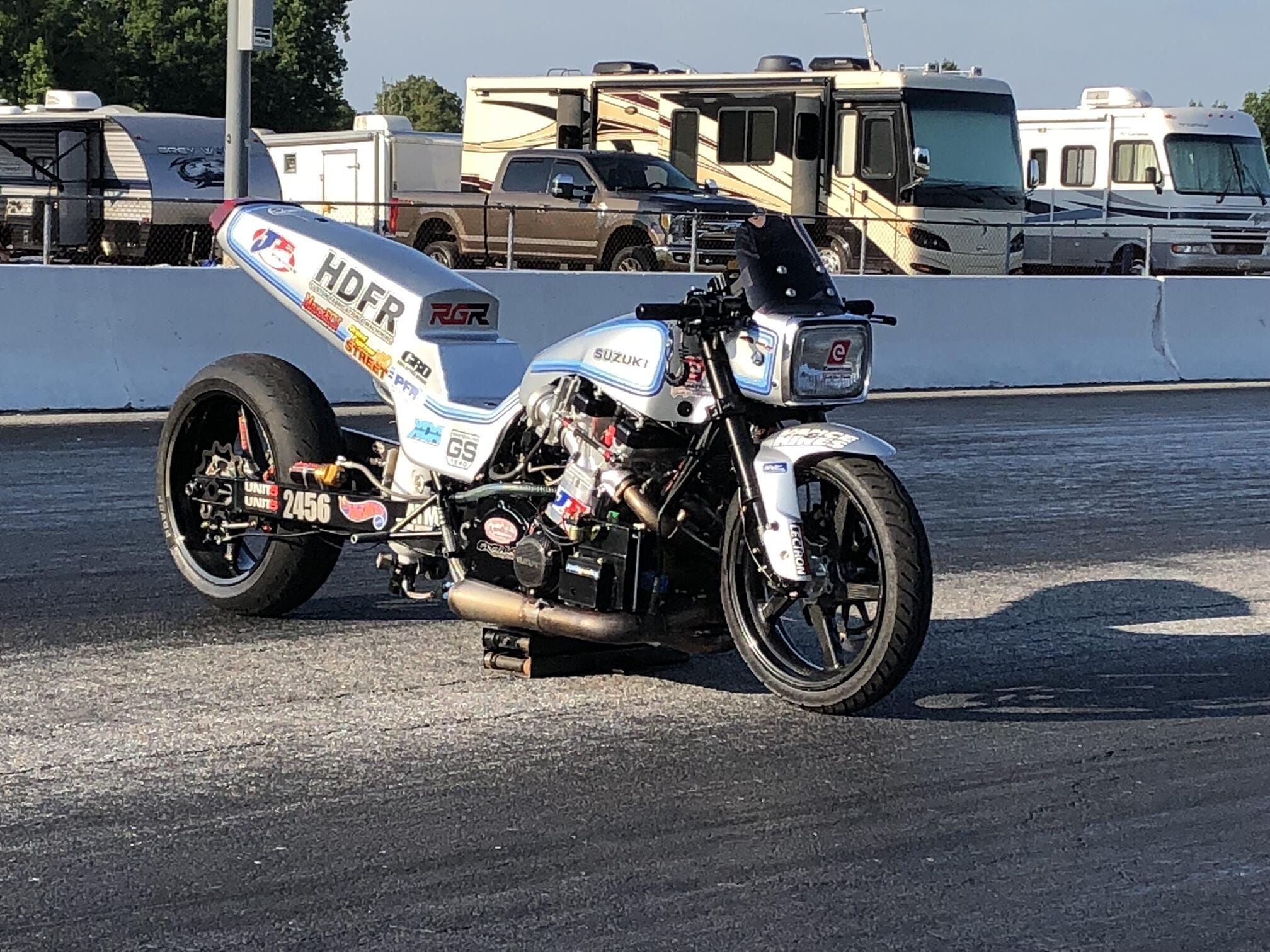
Richard Gadson provides the most thrilling explanation of riding the tuned-up, nitrous-powered Suzuki GS.
“It’s extremely scary. It’s so scary that it ends up being fun in some sick way. It’s like riding a crazy roller coaster. You’re scared half to death, but you want to ride it for the thrill. Not having a fairing gets pretty sketchy at 220 miles an hour. There are a lot of G-forces on your body. You’re fighting the wind. I try to get extremely small by tucking my shoulders and elbows in and get behind the little windscreen that I do have. You can’t get complacent. Something as simple as reaching up to grab the brake lever can be disaster. If I expose my palm or hand to the wind, it will peel me off the bike one hand at a time. Trying not to blow off the bike is the toughest part of my pass. The acceleration is amazing. I can always tell what kind of pass I’m on by the rpms I am in when I cross the finish line. The majority of the pass I’m looking at that, and then the fun part of slowing down begins.” Simply put, it’s like strapping yourself to a rocket and trying to hold on.
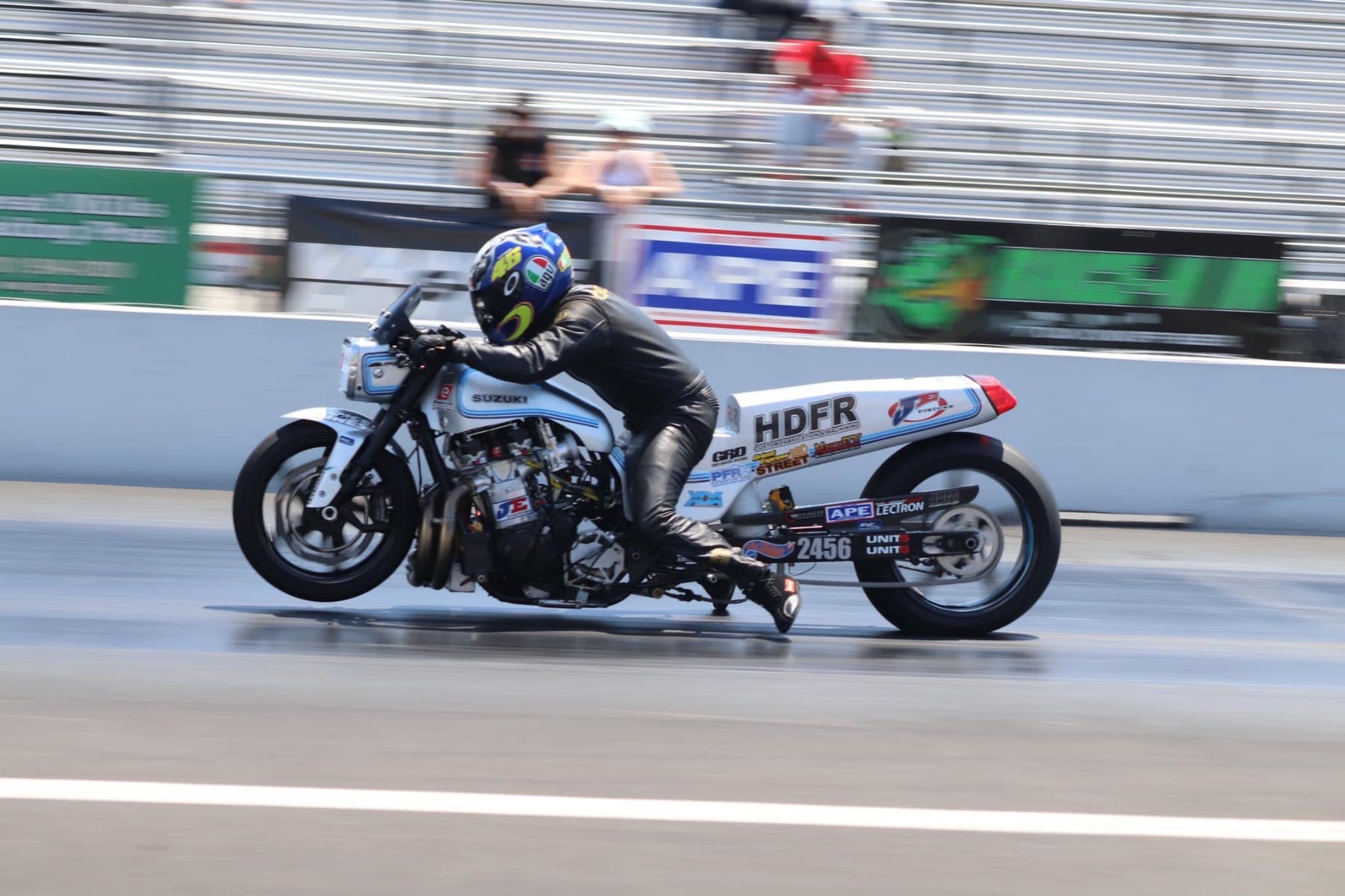
“Something as simple as reaching up to grab the brake lever can be disaster. If I expose my palm or hand to the wind, it will peel me off the bike one hand at a time. Trying not to blow off the bike is the toughest part of my pass.” – Gadson. The feeling of racing can only be accurately described by the racer.
It pays to have friends. Had it not been for Mummert’s buddy, Mike Schultz from HDFR in Frederick, Maryland, Brad would be in the poor house. Schultz covers the labor, while Brad pays the material costs. It helps that Mike shares in the passion of making a world-beater.
Brad Mummert and Richard Gadson don’t appear to intend on stopping anytime soon. They have smashed records, done the unthinkable, had a few setbacks along the way (like when Gadson crashed earlier this year in Virginia), and yet are still striving for more success. It all goes back to rivalry.
Mummert explains it best. “I told Richard that one of my goals was that we go fast enough with this old bike that the rules would need to be changed based on our motorcycle. After this season the word on the street is that they’re going to change the rules because of our bike. They’re going to slow us up or try to take something away in order to make the field more competitive. That was one of the goals, and I think we achieved it. The biggest thing is to have fun and do something that people said wasn’t possible.”
The sky’s the limit for Mummert, Gadson, and the stealthy-fast 39-year-old drag racer.
